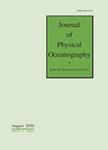版权所有:内蒙古大学图书馆 技术提供:维普资讯• 智图
内蒙古自治区呼和浩特市赛罕区大学西街235号 邮编: 010021

作者机构:Columbia Univ Appl Phys & Appl Math Dept 200 SW Mudd BldgMC 4701500 W 120th St New York NY 10027 USA Columbia Univ Dept Earth & Environm Sci New York NY USA
出 版 物:《JOURNAL OF PHYSICAL OCEANOGRAPHY》 (物理海洋学杂志)
年 卷 期:2016年第46卷第9期
页 面:2785-2805页
核心收录:
基 金:National Science Foundation [OCE 1553593] NSF Frontiers in Earth System Dynamics (FESD) Grant [OCE 1338814]
主 题:Circulation/ Dynamics Ekman pumping/transport Energy transport Mesoscale processes Mixing Atm/Ocean Structure/ Phenomena Eddies Models and modeling Isopycnal coordinates
摘 要:Stratification in the Southern Ocean is determined primarily by a competition between westerly wind-driven upwelling and baroclinic eddy transport. This study investigates the time scales of equilibration of the Southern Ocean in response to changing winds through an idealized channel model. An analytical framework describing the energetic pathways between wind input, available potential energy (APE), eddy kinetic energy (EKE), and dissipation provides a simple theory of the phase and amplitude response to oscillating wind stress. The transient ocean response to variable winds lies between the two limits of Ekman response (high frequency), characterized by the isopycnal slope responding directly to wind stress, and eddy saturation (low frequency), wherein a large fraction of the anomalous wind work goes into mesoscale eddies. The crossover time scale is the time scale of meridional eddy diffusive transport across the Antarctic Circumpolar Current (ACC) front. For wind variability with a period of 3 months (high-frequency forcing), the relative conversion of wind work to APE/EKE is 11, while for a period of 16 years (low-frequency forcing), the relative conversion to APE/EKE reduces to 3. The system s frequency response is characterized by a complex transfer function. Both the phase and amplitude response of EKE and APE predicted by the linear analytic framework are verified using multiple ensemble experiments in an eddy-resolving (4-km horizontal resolution) isopycnal coordinate model. The results from the numerical experiments show agreement with the linear theory and can be used to explain certain features observed in previous modeling studies and observations.